
views
Cleaning Your Boots
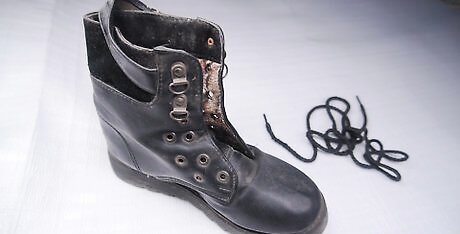
Remove the laces from your boots to access their entire surface. Having easy access to the entire surface of your boots is important for creating an even shine. To create a sturdier space to work on, you can insert shoe trees into your boots. Shoe trees can be replaced by wadding up a newspaper and inserting it into the toe of your boot. For boots with taller necks, wad up some old t-shirts or towels and pack them tightly into the neck of your boots. This will make the necks easier to handle as you polish.
Use your horsehair brush to clean any debris from your boots. This step should always be done before you begin polishing. Even if your boots do not appear to be incredibly dirty, they may still be covered with dust and small debris that may be hard to see. If you just polish over that, you're actually working that dirt deeper into your boots. Start by gently brushing your boot’s surface. Pay close attention to any areas of dirt, dust, and other debris. Make sure that the debris is completely removed before continuing.
Use saddle soap if your boots need a deeper clean. Dip a damp cloth in saddle soap and rub that into your shoes. If you don't have any saddle soap, use just a little baby shampoo mixed with a small amount of water. Either way, make sure not to saturate your shoe when you're cleaning it, as that will damage the leather. Use a welt brush and a dab of water to reach smaller areas and openings in your boot such as the eyelets and the welts. However, do not soak your boot when applying the water. Allow your shoes 10-15 minutes to dry before continuing, and make sure every area of your shoe has dried completely.

Cover your work area with newspapers or a towel. Polishing your boots can be a messy ordeal. Make sure to take the proper precautions before applying your polish and save yourself the potential frustration of dealing with a stained kitchen table. Don’t use your favorite bathroom or kitchen towels to cover the area as some polishes can leave a permanent stain. Do not wear your boots for at least 24 hours after polishing.
Applying the Polish
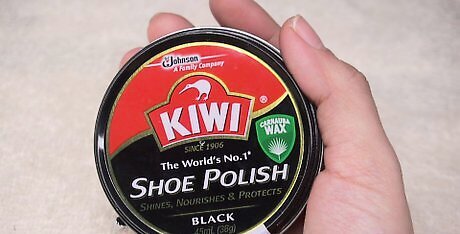
Use a cream or wax based polish. These will provide better nourishment and coloring for your boots. Wax based polishes have a higher concentration of hard wax that will create a better shine. Because of the stronger concentration of wax, this type of polish will help you protect your boots from liquids, scratches, and scuffs. For oil-tanned leather, use an oil or conditioner for polishing. Simply use a clean cloth, dab it into the oil or conditioner, and lightly spread it thoroughly across your boot. Oil-tanned leather will have been treated with oil to help make the boots more resistant to various types of weather. When treating suede or rough out based leather, do not use oil, polish, or conditioner, as it is not needed. Use a leather protector spray instead.
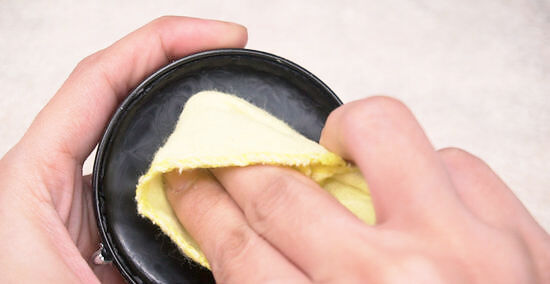
Dip one corner of a clean, lint-free rag into your polish. Begin by only submerging one corner of the cloth into your polish at a time. Ensure that the corner gets fully saturated before you start applying the polish to your boots. Ensuring that the corner of your cloth is saturated before applying your polish will help you create a smooth, even coat. This will also help prevent you from making the coat too thick.
Use a small, circular motion to apply your polish. Begin applying the polish to one small area, such as the toe of your boot, at a time. This will ensure that you are not missing any scuffs or scrapes that could possibly be overlooked. Continue to use small, circular motions as you apply polish to the remaining area of your boot, re-saturating your cloth with polish as needed. Only apply a very thin layer of the polish to your shoes—if you put on too much, it's just going to sit on the surface of the leather, and it's not going to soak in. Using a circular motion will help the wax or cream to spread evenly over the surface of your boot.

Make sure to polish the welts of your shoes. To do so, dip a welt brush or toothbrush into the polish. Apply the polish to your boot using small, circular motions, when able to. This brush will also come in handy when you are ready to polish the heel and other small areas. The welt strip is a piece of leather that is used to attach the insole and outsole of your boots. Neglecting to polish this area will affect the sleekness of your finished product.

Allow your polish to dry for at least 10 minutes. Once you have completely covered your boot with your polish, allow the polish to dry completely before moving on. Some heavier polishes may require longer drying times. Be sure to check your polish’s container for possible drying time alternatives.
Use a quick, side-to-side motion to buff your boots gently. This will be a very light buff to ensure you have polished the entire surface of your shoe and did not miss any spots. You will know it is working when a glossy shine begins to come through. Don't scrub your boot harshly—this should be a very gentle process. Don’t go back and fix any missed areas just yet. Finish all of the steps for your first polish before repeating steps on missed areas.

Wipe your boot with the clean parts of your rag. This will remove any extra wax or cream that may be left on the surface. Removing any excess cream or wax will help your boots dry evenly, preventing areas of buildup. Make sure you are only using clean parts of the rag. If you don’t feel that you have enough clean area left on your rag, grab a new one. It is important that, when wiping your boots down, the rag you use is free from polish that may re-saturate your boots.
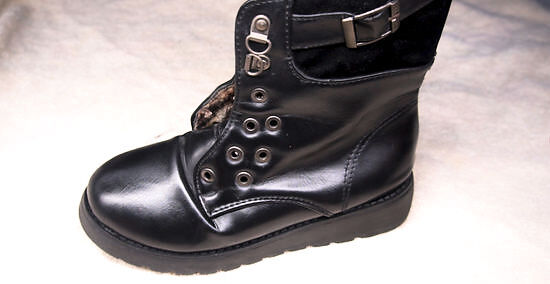
Allow your boots to sit for another 10 minutes. Before continuing, you need to make sure that your boots are completely dry. Even if you decide not to buff or shine them, they must be dry before you wear them. Wearing boots with wet polish can increase the risk of scuffs and cracks. This can happen when your polish is not allowed enough time to form a protective coating over its surface.

Repeat the steps as needed to remove tougher stains. For deeper stains or wear, repeat the previous process. Your ideal finished boot will have a waxy or matte finish to it. This is also the time you will want to go back and re-polish any areas that were missed during the first application.
Buffing and Shining Your Boots
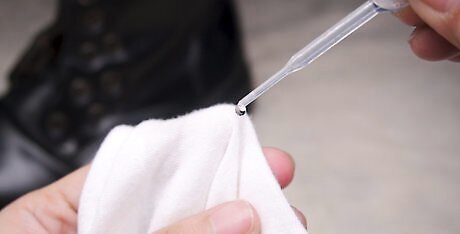
Place 1-2 drops of warm water onto a cotton cloth. Wrap a clean piece of a cotton cloth securely around your index finger, molding it as close to the outline of your finger as you can. Add the water to the tip of the cloth on your finger. This will help you make sure that you are applying an even coat of wax. If there are too many folds in your cloth, it can cause an uneven layer.

Add a small amount of wax to the damp cloth on your fingertip. The smaller amount of wax you use here, the better. Using too much wax will take too long to dry and will not dry evenly. Thick layers of wax can cause the wax to be absorbed by the leather and will ruin the base coat you just made.
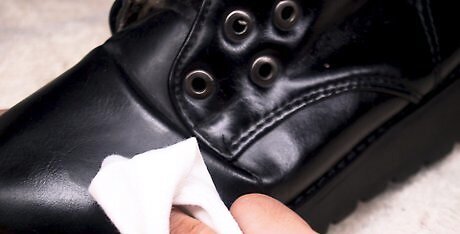
Use a small, quick circular motion to apply the wax. You will want to have a very light touch while applying the wax. If you press too hard during application, you could be rubbing off any polish that has not yet been completely dissolved. Instead, you want to use the small amount of wax to create a light, smooth coat over the hardened polish. Do not worry if there is an increase in friction between your finger and your boot along with a matted or cloudy texture. This only means that the wax is beginning to harden and you will want to continue shaping it into a smooth layer. If needed, you can add a drop of water to the hardening wax and continue to massage it with light, circular motions. Continue to add one drop of water at a time until the matted texture disappears.

Allow the wax to dry for at least 10-15 minutes. Providing the wax the appropriate amount of time to dry will prevent thick layers of wax from building up. If you don’t allow your wax to dry thoroughly, it will prevent the wax from building a protective layer. Allowing the wax time to dry is particularly important if you plan to apply another layer.
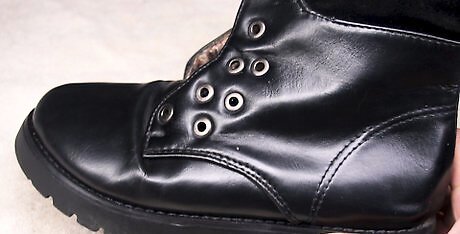
Reapply the wax until you achieve your desired level of shine. Even when reapplying the wax, make sure to follow the previous steps exactly. Applying too much wax will create a hard surface that will not result in a shiny finish. Be patient during this process. Depending on the state of your boots, they may take more applications of wax for your desired outcome. Don’t rush the process, as rushing through the steps will not help you get your desired finish.




















Comments
0 comment